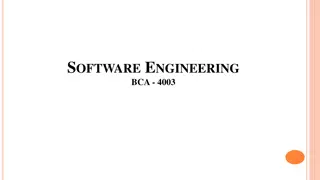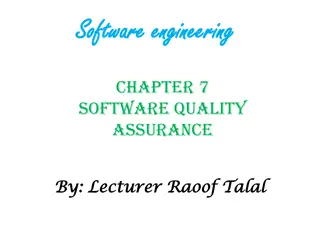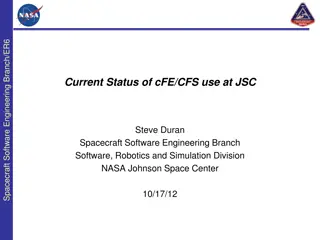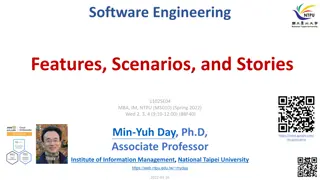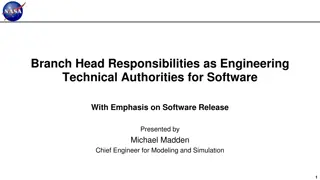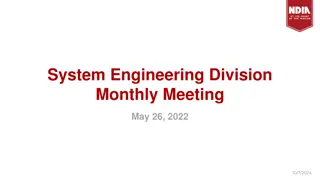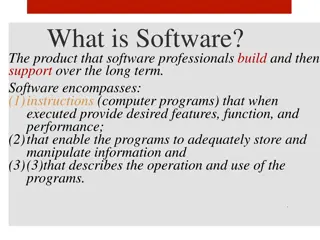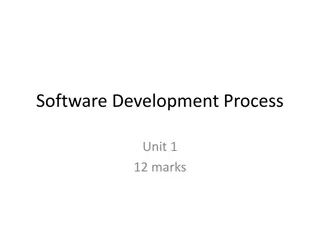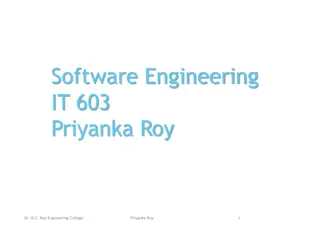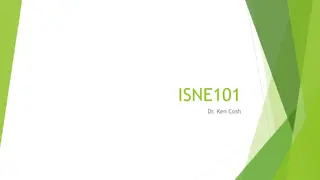Understanding Software Engineering: Concepts and Characteristics
Software engineering involves the application of scientific principles and methods to develop efficient, reliable software products. The need for software engineering arises due to factors like large software size, scalability, cost concerns, dynamic nature, and quality management. Good software exhibits operational characteristics like usability and correctness, along with transitional features such as portability and maintainability. Choosing a suitable software life cycle model is crucial for successful project development.
Download Presentation

Please find below an Image/Link to download the presentation.
The content on the website is provided AS IS for your information and personal use only. It may not be sold, licensed, or shared on other websites without obtaining consent from the author. Download presentation by click this link. If you encounter any issues during the download, it is possible that the publisher has removed the file from their server.
E N D
Presentation Transcript
INTRODUCTION INTRODUCTION What is Software Engineering? What is Software or Engineering? IEEE definition of Software Engineering
INTRODUCTION Software is more than just a program code. A program is an executable code, which serves some computational purpose. Software is considered to be a collection of executable programming code, associated libraries and documentations. Software, when made for a specific requirement is called software product. Engineering on the other hand, is all about developing products, using well- defined, scientific principles and methods. So, we can define software engineering as an engineering branch associated with the development of software product using well-defined scientific principles, methods and procedures. The outcome of software engineering is an efficient and reliable software product.
NEED OF SOFTWARE ENGINEERING Large software - It is easier to build a wall than to a house or building, likewise, as the size of software become large engineering has to step in to give it a scientific process. Scalability- If the software process were not based on scientific and engineering concepts, it would be easier to re-create new software than to scale an existing one. Cost- As hardware industry has shown its skills and huge manufacturing has lower down the price of computer and electronic hardware. But the cost of software remains high if proper process is not adapted. Dynamic Nature- The always growing and adapting nature of software hugely depends upon the environment in which the user works. If the nature of software is always changing, new enhancements need to be done in the existing one. This is where software engineering plays a good role. Quality Management- Better process of software development provides better and quality software product.
CHARACTERESTICS OF GOOD SOFTWARE Well-engineered and crafted software is expected to have the following characteristics: Operational - This tells us how well software works in operations. It can be measured on: Budget Usability Efficiency Correctness Functionality Dependability Security Safety
CHARACTERESTICS OF GOOD SOFTWARE Transitional - This aspect is important when the software is moved from one platform to another: Portability Interoperability Reusability Adaptability Maintenance - This aspect briefs about how well a software has the capabilities to maintain itself in the ever-changing environment: Modularity Maintainability Flexibility Scalability
THE NEED FOR A SOFTWARE LIFE CYCLE MODEL The development team must identify a suitable life cycle model for the particular project and then adhere to it. Without using of a particular life cycle model the development of a software product would not be in a systematic and disciplined manner. When a software product is being developed by a team there must be a clear understanding among team members about when and what to do. Otherwise it would lead to chaos and project failure. A software life cycle model defines entry and exit criteria for every phase. A phase can start only if its phase-entry criteria have been satisfied. So without software life cycle model the entry and exit criteria for a phase cannot be recognized. Without software life cycle models it becomes difficult for software project managers to monitor the progress of the project.
Different software life cycle models A few important and commonly used life cycle models are as follows: Classical Waterfall Model Iterative Waterfall Model Prototyping Model Evolutionary Model Spiral Model
CLASSICAL WATERFALL MODEL CLASSICAL WATERFALL MODEL
1. FEASIBILITY STUDY FEASIBILITY STUDY The main aim of feasibility study is to determine whether it would be financially and technically feasible to develop the product. At first project managers or team leaders try to have a rough understanding of what is required to be done by visiting the client side. They study different input data to the system and output data to be produced by the system. After they have an overall understanding of the problem they investigate the different solutions that are possible. Then they examine each of the solutions in terms of what kind of resources required etc. Based on this analysis they pick the best solution and determine whether the solution is feasible financially and technically. They check whether the customer budget would meet the cost of the product and whether they have sufficient technical expertise in the area of development.
2.REQUIREMENTS ANALYSIS AND SPECIFICATION REQUIREMENTS ANALYSIS AND SPECIFICATION The aim of the requirements analysis and specification phase is to understand the exact requirements of the customer and to document them properly. This phase consists of two distinct activities, namely Requirements gathering and analysis Requirements specification The goal of the requirements gathering activity is to collect all relevant information from the customer regarding the product to be developed. This is done to clearly understand the customer requirements so that incompleteness and inconsistencies are removed. The requirements specification activity start after all the requirements are properly understood. The customer requirements identified during the requirements gathering and analysis activity are organized into a SRS document. The important components of this document are functional requirements, the nonfunctional requirements, and the goals of implementation.
3. DESIGN DESIGN The goal of the design phase is to transform the requirements specified in the SRS document into a structure that is suitable for implementation in some programming language. Two distinctly different approaches are available: Traditional design approach -This consists of two different activities; first a structured analysis of the requirements specification is carried out where the detailed structure of the problem is examined. This is followed by a structured design activity. During structured design, the results of structured analysis are transformed into the software design. Object-oriented design approach -In this technique, various objects that occur in the problem domain and the solution domain are first identified, and the different relationships that exist among these objects are identified. The object structure is further refined to obtain the detailed design.
4. CODING AND UNIT TESTING CODING AND UNIT TESTING The purpose of the coding phase (sometimes called the implementation phase) of software development is to translate the software design into source code. Each component of the design is implemented as a program module. The end-product of this phase is a set of program modules that have been individually tested. During this phase, each module is unit tested to determine the correct working of all the individual modules.
5. INTEGRATION AND SYSTEM TESTING INTEGRATION AND SYSTEM TESTING During the integration and system testing phase, the modules are integrated in a planned manner. Integration is normally carried out incrementally over a number of steps. During each integration step, the partially integrated system is tested and a set of previously planned modules are added to it. Finally, when all the modules have been successfully integrated and tested, system testing is carried out. The goal of system testing is to ensure that the developed system conforms to its requirements laid out in the SRS document. testing: It is the system testing performed by the development team. testing: It is the system testing performed by a friendly set of customers. Acceptance testing: It is the system testing performed by the customer himself after the product delivery to determine whether to accept or reject the delivered product.
6. MAINTENANCE MAINTENANCE Maintenance of a typical software product requires much more than the effort necessary to develop the product itself. Many studies carried out in the past confirm this and indicate that the relative effort of development of a typical software product to its maintenance effort is roughly in the 40:60 ratios. Maintenance involves performing one or more of the three kinds of activities: Correcting errors that were not discovered during the product development phase. This is called corrective maintenance. Improving the implementation of the system, and enhancing the functionalities of the system according to the customer s requirements. This is called perfective maintenance. Porting the software to work in a new environment. For example, porting may be required to get the software to work on a new computer platform or with a new operating system. This is called adaptive maintenance.
SHORTCOMINGS OF THE CLASSICAL WATERFALL MODEL The classical waterfall model is an idealistic one since it assumes that no development error is ever committed by the engineers during any of the life cycle phases. However, in practical development environments, the engineers do commit a large number of errors in almost every phase of the life cycle. The source of the defects can be many: oversight, wrong assumptions, use of inappropriate technology, communication gap among the project engineers, etc. These defects usually get detected much later in the life cycle. For example, a design defect might go unnoticed till we reach the coding or testing phase. Once a defect is detected, the engineers need to go back to the phase where the defect had occurred and redo some of the work done during that phase and the subsequent phases to correct the defect and its effect on the later phases.
ITERATIVE WATERFALL MODEL Here, feedback paths are provided for error correction as & when detected later in a phase. Though errors are inevitable, but it is desirable to detect them in the same phase in which they occur. If so, this can reduce the effort to correct the bug. The advantage of this model is that there is a working model of the system at a very early stage of development which makes it easier to find functional or design flaws. Finding issues at an early stage of development enables to take corrective measures in a limited budget. The disadvantage with this SDLC model is that it is applicable only to large and bulky software development projects. This is because it is hard to break a small software system into further small serviceable increments/modules.
PROTOTYPING MODEL A prototype is a toy implementation of the system. A prototype usually exhibits limited functional capabilities, low reliability, and inefficient performance compared to the actual software. A prototype is usually built using several shortcuts. The shortcuts might involve using inefficient, inaccurate, or dummy functions. A prototype usually turns out to be a very crude version of the actual system. Need for a prototype in software development how the screens might look like how the user interface would behave how the system would produce outputs
PROTOTYPING MODEL A prototype of the actual product is preferred in situations such as: User requirements are not complete Technical issues are not clear
EVOLUTIONARY MODEL It is also called successive versions model or incremental model. At first, a simple working model is built. Subsequently it undergoes functional improvements & we keep on adding new functions till the desired system is built. Applications: Large projects where you can easily find modules for incremental implementation. Often used when the customer wants to start using the core features rather than waiting for the full software. Also used in object oriented software development because the system can be easily portioned into units in terms of objects. Advantages: User gets a chance to experiment partially developed system Reduce the error because the core modules get tested thoroughly. Disadvantages: It is difficult to divide the problem into several versions that would be acceptable to the customer which can be incrementally implemented & delivered.
SPIRAL MODEL First quadrant (Objective Setting) During the first quadrant, it is needed to identify the objectives of the phase. Examine the risks associated with these objectives. Second Quadrant (Risk Assessment and Reduction) A detailed analysis is carried out for each identified project risk. Steps are taken to reduce the risks. For example, if there is a risk that the requirements are inappropriate, a prototype system may be developed. Third Quadrant (Development and Validation) Develop and validate the next level of the product after resolving the identified risks. Fourth Quadrant (Review and Planning) Review the results achieved so far with the customer and plan the next iteration around the spiral. Progressively more complete version of the software gets built with each iteration around the spiral.
COMPARISON OF DIFFERENT LIFE-CYCLE MODELS The classical waterfall model can be considered as the basic model and all other life cycle models as embellishments of this model. However, the classical waterfall model cannot be used in practical development projects, since this model supports no mechanism to handle the errors committed during any of the phases. This problem is overcome in the iterative waterfall model. The iterative waterfall model is probably the most widely used software development model evolved so far. This model is simple to understand and use. However this model is suitable only for well- understood problems; it is not suitable for very large projects and for projects that are subject to many risks. The prototyping model is suitable for projects for which either the user requirements or the underlying technical aspects are not well understood. This model is especially popular for development of the user-interface part of the projects.
COMPARISON OF DIFFERENT LIFE-CYCLE MODELS The evolutionary approach is suitable for large problems which can be decomposed into a set of modules for incremental development and delivery. This model is also widely used for object-oriented development projects. Of course, this model can only be used if the incremental delivery of the system is acceptable to the customer. The spiral model is called a meta model since it encompasses all other life cycle models. Risk handling is inherently built into this model. The spiral model is suitable for development of technically challenging software products that are prone to several kinds of risks. However, this model is much more complex than the other models this is probably a factor deterring its use in ordinary projects.


